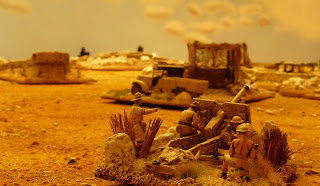I visited my war games club, The New Buckenham Historical Wargamers Club, last Friday with the intention of putting on a game to begin getting the club members accustomed to the rules that will be used for the larger all day refight.
We will be using the popular Rapid Fire rules but I have made some amendments to make them a little easier to play and reduce individuals 'waiting time'
I am happy to go into details of these changes on a later post but here I would like to stick to the game.
The table consisted of a trench line, covered by a minefield and lined with barb wire.
Here is a close up of the sections of the French position, as yet unmanned.
The trench scenery is all scratch built. It is built in a modular form so that it can be arranged in a multitude of configurations. In the case of the second picture the sangar is a resin item, (I believe from Mainly Military), and then the trench is built around it.
Lastly an overview of the battlefield. The defences are unoccupied because defenders figures are not placed on the table until they have been successfully spotted by the opposition. This stops their presence on the table influencing the opening dispositions of the attackers. Some intelligence can be passed to the opposition by the umpire before the start of the game but it shall be historically based and not 'all seeing'.
I also added a few 'photo opportunities' Here the French forces had many bunkers or further sangars to protect their soft skins against the continual Axis air attacks that the defenders suffered over many of the 17 days they held the position.
This is an SHQ Chevrolet model with an SHQ driver and various boxes and 'flimsies' from various suppliers.
The Axis forces advanced in two discreet columns. The Italians on the left and the Germans on the right. Here the Germans with artillery support but no tanks debuss early and advance towards the barb wire.
The figures are from my own collection. They are a mix of suppliers including Kellys Heroes, from Grubby Tanks, SHQ, IT, (now supplied from S & A Scenics), and some Wargames Foundry.
Here the artillery support for the DAK consisted of a newly owned British 25lbr watched on by a despatch rider from Millicast with his SHQ motorcycle combination.
Here he is looking on.
And the front view of the German acquisition. Figures are AB and the model is from ESCI/Italieri.
As mentioned the Germans debussed early and left their transport at the extreme range of the French artillery, obviously aware of the difficulty of getting replacements across the Mediterranean!
Here is the view of the German advance coming under artillery fire as they advance.
From a distance the Italian advance can be seen at the bottom of this picture.
meanwhile on the other flank the Italians used their transport to take them up to the barb wire. They allowed their tank support to lead the way, (using a rule amendment where the dust raised by the tanks stops the defenders from being able to spot anything behind them). the tanks, (M13/40s), breech the wire and start to cross the minefield. The infantry support debuss and follow tanks through the now mangled barb wire. Fortunately the Italians suffered only minimal damage to the minefield but the flanking fire from one of the French 75mm field guns made its presence felt!
Meanwhile back to the Germans, after receiving some bombardment from a French gun position, was silenced when a smoke screen was laid in front of the position. This artillery fire slowed down the DAK advance as they went to ground but continued to crawl forward. unfortunately this also interfered with their ability to spot their enemy.
By now the Germans had reached the barb wire line and were breeching it. Mo longer hindered by the French artillery fire they were now being greeted by IDF from the French mortars and the French 25lbr.
This model is also an ESCI/Italieri but this time I have used most of the original crew with a resin figure pointing wearing a colonial helmet, from Resicast or Solfig?
Italian tank support was transitory as hits on the advancing squadron and morale dice throws did not compel them to remain with the infantry!
However the infantry launched an attack on the trench line while being assailed by fire from the French bren carriers.
From the other side of the table the Italian assault was shrouded in smoke.
The Italian tanks fell back, leaving the divisions Semovente to continue providing support but the M13/40 soon returned. However they continued to suffer losses. The Italian infantry assault failed and after another attempt they withdrew. The Germans on the other side of the battlefield reached the French lines but failed to spot much until too late to soften the opposition beforehand.
The morale of the French Legion defenders helped them well but in the actual battle some of their defence was almost fanatical, so was felt to be realistic.
Lastly I include two photographs of one of the many smaller vehicles I have. This is an SHQ kublewagen with crew from the same supplier. The aerial is a cat whisker.
Further pictures are on the clubs facebook page, here






















No comments:
Post a Comment